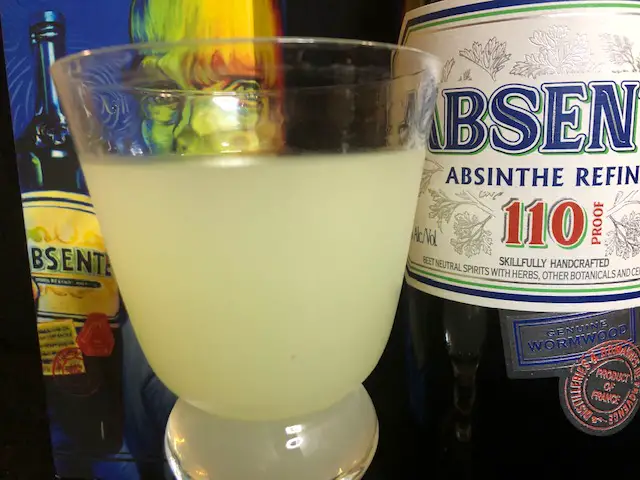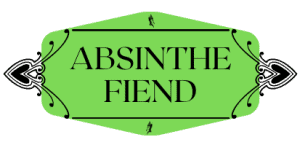With a distinctive logo and presence on virtually every liquor store shelf, it’s hard not to be aware of Absente.
This is a curious offering that is equal parts popular and controversial.
I’ve received numerous requests for this article, so I suppose it’s time to go ahead and dive into Absente “Absinthe Refined” with this review.
Let’s get into it!
What is Absente?
Ever since absinthe was relegalized in the US, Absente (and its iconic, trippy Van Gogh artwork) has been found on store shelves everywhere. For many years, the only options in most stores were Absente or Lucid Absinthe Supérieure.
By acting quickly to get on store shelves immediately after the absinthe ban was lifted (and with some standout marketing and packaging), Absente was able to make a name for itself.
For most American absintheurs that discovered the Green Fairy between 2007 and 2012, it’s a safe bet that Absente was their introduction. If it wasn’t their first, it was certainly among them. (It was my third and was preceded by Lucid and one that is no longer produced, Le Tourment Vert.)
Between the brand’s timing, marketing, and the overall absinthe renaissance that came with relegalization, Absente has also found itself at the center of plenty of controversies in the absinthe world.
While we’re going to focus on the product itself for right now, we’ll visit the primary controversy in just a moment.
Absente is a liqueur from Distilleries et Domaines de Provence. It is 110 Proof containing 55% ABV.
Recommended: How to Properly Prepare Absinthe (Beginner Friendly Guide)
Aroma
Absente has a remarkably subtle aroma. While a sweet scent dominated by star anise is most prevalent, it’s very delicate.
When preparing Absente, the aroma opens up slightly with the addition of water. However, it is still curiously subtle with only a sweet anise smell standing out.
Where most absinthes would have a strong aroma filled with complex layers of herbs (especially once water is added), this is very uniform.

Color & Louche
Unlouched, the color is a brilliant green which is a color that I would expect from any proper absinthe verte that hasn’t had time to change colors.
Though I have to deduct points for the use of artificial coloring. As pretty as the green hue may be, I’m a major stickler when it comes to artificial coloring in absinthe.
There are no bits of sediment left over from the distillation process.
Preparing Absente, adding water paves the way for a light-medium opalescent louche. The clouds are clear and swirl nicely though the oily-textured depth of the louche that I personally enjoy so much is not there.
All in all, it’s a nice louche.
Flavor & Mouthfeel
First things first: Absente is very sweet.
It’s made with neutral beet spirits, but the sweetness reveals that there is extra sugar added to the bottle.
I’d recommend not using a sugar cube in your own preparation as the sweetness is just a tad overwhelming.
As for the flavor itself, Absente is seemingly pure star anise. I love anise and the fun numbing sensation that comes with it, but this is a one-note song. With none of the complexity and flavor “story” that I would expect from any absinthe, it feels boring. Additionally, the sweetness has a way of lingering on the palate for quite some time.
As expected from watching the louche, the texture is also nonexistent. Where most absinthes are rich in oils from the herbs that add depth and character to the texture of each sip, this is just very uniform and light.
Recommended: How to Taste Absinthe Like a Pro

Is Absente Real Absinthe?
The lion’s share of controversy around Absente comes down to whether or not it’s real absinthe.
Absente markets itself as “Absinthe Refined” but it’s more “Absinthe Adjacent” than anything. It’s not just another liqueur, but it’s much closer to being a pastis than it is a proper absinthe.
While the anise flavor is certainly present, the other herbal flavors and textures that make absinthe so enchanting are nowhere to be found.
Related: Absinthe vs Pastis – What’s the Difference?
Of course, there is also the wormwood controversy with Absente…
A true absinthe is made with Grande Wormwood (Artemisia Absinthium) though imitators will often substitute Grande Wormwood for alternatives.
Absente, for example, initially used Southern Wormwood (Artemisia abrotanum). However, things got even stickier for Absente when they claimed that it was Petite Wormwood (also known as Roman Wormwood, Artemisia pontica) that they were using.
For many years, Absente used lesser wormwood though they have recently (since around 2016) begun claiming to use Grande Wormwood.
While Absente does a great job with its marketing in most aspects, they’ve had a habit of sending mixed messages. At times these have led to a kind of misrepresentation of what Absente is which, unsurprisingly, has irritated many absintheurs.
Conclusion – Reviewing Absente
While I’m not particularly a fan of Absente, I do tend to keep a bottle on my shelf. I like to have friends over with some regularity for “absinthe nights” and Absente makes for a good option to offer those who aren’t sure if they’ll like absinthe or not.
Worst case, I would rather waste some of this than one of my more premium absinthes like the Jade Nouvelle Orleans or LaRusée Bleue.
It can also be useful for certain cocktails like the Sazerac where the absinthe is used for a quick rinse and then disposed of.
Maybe saying Absente is “a good absinthe to waste” is a backhanded compliment, but that’s where it’s found itself for me.
I’m not banishing Absente to the dreaded 1-star dungeon. However, I’m also not keen to give it a seat at the table alongside other proper absinthes.
It’s not a terrible introduction to the Green Fairy for beginners, but you could also do a lot better.
As such, I give Absente “Absinthe Refined” a take-it-or-leave-it rating of 2 stars out of 5.
